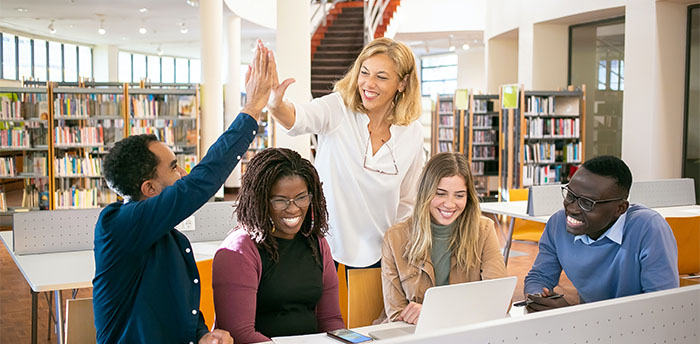On a bright and crisp morning on March 8th, 2023, the 5th meeting of the Instructional Innovative Fellows convened at Bartlett Hall. Three innovative fellows shared their unique approaches to teaching, centered around promoting learners’ agency and co-creating educational resources for 21st-century learning. Kelsey Whipple proposed utilizing the University Museum of Contemporary Art (UMCA) to encourage active learning and critical thinking among her students. Jennie Donohue transformed Canva, a digital design tool, into a platform for professional design creations, while Torrey Trust demonstrated the power of Open Educational Resources (OER) as a means of student-driven learning materials. Together, these educators are leading the way in innovative and student-centered teaching practices.
- UMCA provides comprehensive art-based educational resources
- Canva makes designing accessible for students
- OER promotes the co-creation of learning materials
Let’s Visit UMCA – Learning from the Arts
Teaching and learning aren’t limited to the classroom. Kelsey has found an innovative way to incorporate hands-on learning into her teaching: by taking her students to The University Museum of Contemporary Art (UMCA). The UMCA is a teaching museum with diverse art collections and education programs, making it a perfect place for students to reflect, think critically, and engage with art.
Through close reading and analysis of art, Kelsey encourages her students to reflect on what the art represents and how it relates to socio-cultural and political values. For example, students can analyze gender representation in the arts, enabling them to make meaning and reflect on the art in their own lives. Kelsey also promotes critical thinking by encouraging students to analyze and critique the art pieces, taking notes on their observations, and discussing their findings and interpretations with their peers.
In addition to these activities, Kelsey has also designed scavenger hunts to make visiting the museum more engaging and entertaining. She positions UMCA as a meditation and escape space, where students can deeply reflect on the art and its meaning, enhancing their mental state and enjoying a sense of freedom and flexibility beyond the classroom. The museum staff and student educators are always ready to help and are open to partnerships with various disciplines, making it a rich place for students to learn from different fields. UMCA is truly an exceptional resource for students, and Kelsey has found a fantastic way to incorporate it into her teaching.
Let’s Use Canva – Going Beyond a Design Tool
Jennie has taken her business and marketing classes to the next level by incorporating Canva, a popular design tool, into her teaching. She’s found that Canva’s thousands of free design templates are not only accessible but also easy to use, making it a great resource for her students.

Jennie has used Canva in various class projects, from first-year courses to senior courses, allowing her students to create professional and creative content aligned with course topics. Her students have created everything from infographic posters to branded “client” content for social media promotion, video storyboards, and presentations. Jennie has even used Canva for student organization activities, where students designed marketing collateral, logos, flyers, posters, recognition awards, and certificates.
By providing recommended templates for first-year students and giving upper-level students the flexibility to choose their templates, Jennie has seen increased engagement and creativity among her students. With Canva’s vast array of design templates, students can create impressive and impactful content that aligns with their interests and course topics. Overall, Jennie’s innovative approach to teaching with Canva has transformed the way her students learn and create.
Let’s Create OER – Transforming Teaching and Learning Materials
What happens when students help make learning materials? Torrey’s approach to teaching through Open Educational Resources (OER promotes collaboration, creativity, and innovation among students. By co-creating and publishing OER materials, students can learn the value of sharing knowledge and resources with a wider global community. OER projects can take many forms, such as videos, podcasts, interactive images, educational apps, and games, and can be created using free tools likeGoogle Forms, Adobe Express, Canva, Audacity, and Genial.ly, among others.
Torrey showcased several OER projects she has co-created with students, including an eBook, Online Tools for Teaching and Learning. Millions of educators worldwide have accessed these resources online, a clear indication of the importance of expanding the reach of educational resources beyond individual university campuses. As an instructor, adopting OER projects in your teaching can enhance the learning experience of your students, improve their motivation and attitudes, and increase their awareness of open copyright content. Moreover, OER projects can make education more accessible, affordable, and equitable, especially for students from underserved communities. By embracing OER projects, you can create a culture of collaboration and innovation that aligns with the 21st-century skills your students need to succeed in a globalized world. Furthermore, by co-creating and publishing OER materials, your students can feel empowered knowing that their creations can help educators and students around the world, making a positive impact on society.
*Read more about the benefits of OER in education in one of Torrey’s recent publications.
We are eagerly looking forward to the 6th meeting and what it has in store. To explore more innovative teaching ideas and tools, make sure to check out our other blog posts.
